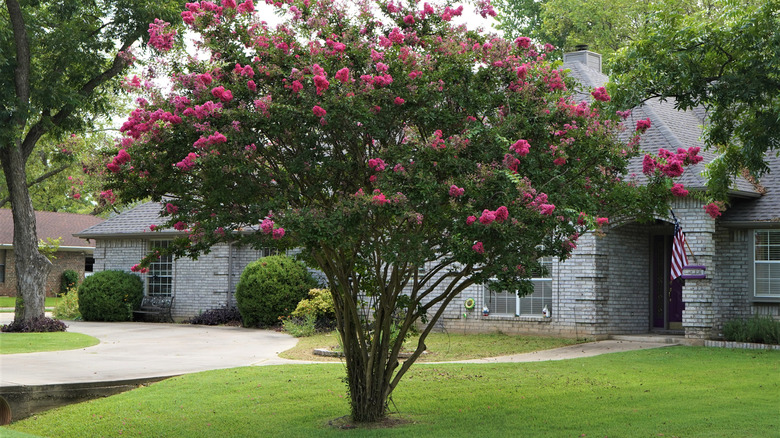Why Your Leaning Crepe Myrtle Needs To Be Staked—and How To Do It Correctly
When you need to add a pop of color to your landscape, the crepe myrtle is worth considering. You can grow this highly ornamental flowering plant as a large tree or a smaller shrub. However, crepe myrtles can cost a pretty penny, up to $400 for a small tree. That makes it important to give them support when they need it — quite literally. While these shrubs are considered relatively low-maintenance, they have a tendency to lean to the side when young. Leaning trees are unsightly, more likely to fall during windstorms, and can develop unstable root balls. Stake your crepe myrtle using sturdy wooden posts and some simple ties.
The common crepe myrtle (Lagerstroemia indica) is one of the most versatile and beautiful low-maintenance trees that you will want in your landscaping. It gets its name from its vibrant pink flowers, the petals of which resemble crepe paper. Native to warm eastern Asia, crepe myrtles are hardy in Zones 6 to 9 and prefer a full sun spot in the garden. As such, they're popular across much of the southern and central U.S. However, to prevent the dreaded lean, these lilacs of the South need to be staked for their first year of growth. This is especially true in windy areas, when the sapling can't support itself, or when the tree is top-heavy with foliage and flowers.
The correct way to stake a leaning crepe myrtle
While overpruning is one of the big mistakes everyone makes when growing crepe myrtles, not properly staking a young tree is also problematic. Fortunately, this isn't a costly or difficult gardening project. All you need are two 8-foot pressure-treated posts, a few pieces of drip line, and some bendable wire. Tool-wise, you'll need some wire snips and a post driver to drive the posts into the ground. Ready to get started? Drive a post into the garden bed or lawn about a foot or so away from each side of the tree. Make sure you angle it away from the tree to avoid damaging the roots. Next, cut a length of wire much longer than the drip line, and thread it through. Wrap the drip line and wire around the crepe myrtle's trunk about one-third of the way up, then wrap the wire around the stake. Repeat on the other side.
@diegocastaaa Slanted Tree? Lets Fix It
Having a post on each side of the trunk helps balance the tree, and the drip tube protects the wire from cutting into the tree's trunk. The latter is something that could cause wounds, opening the tree to infection or pest predation, or strangle the trunk, cutting off the flow of sap. If you're staking a sapling, you may be able to skip the 8-foot pressure-treated posts and instead use small wooden stakes at about 2 inches wide and 5 feet long. You'll still want to follow the previous instructions on how to straighten a leaning tree in your yard, though. Place a stake on each side of the tree and use the drip line — or sections of old garden hose or thick cloth — to protect the trunk from the wire.

